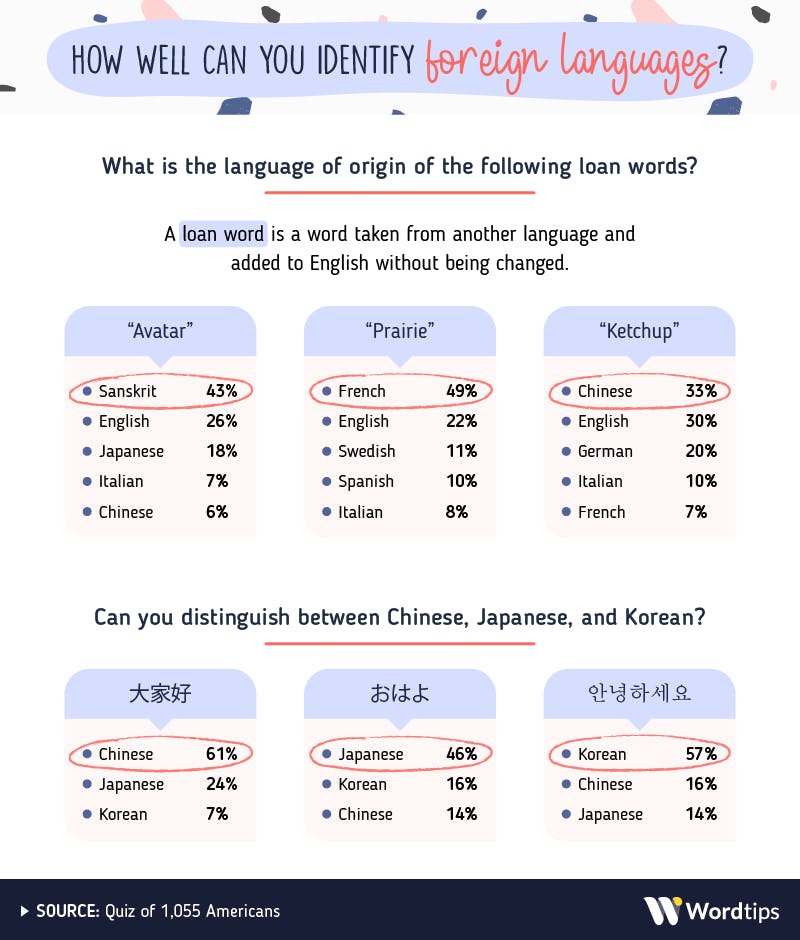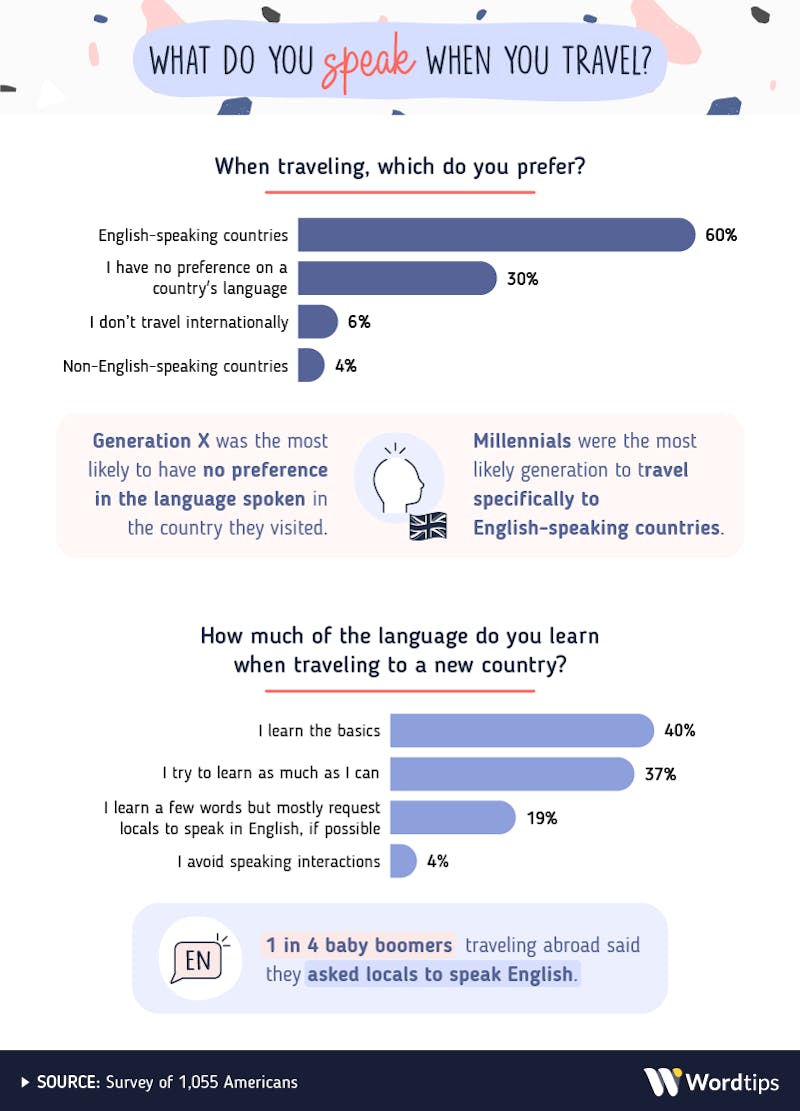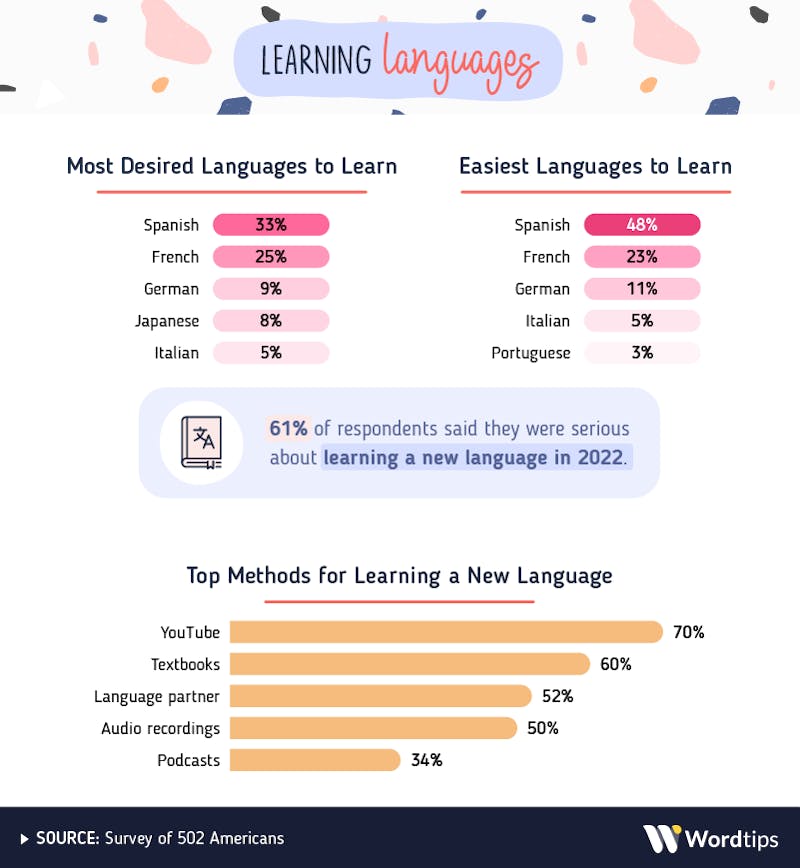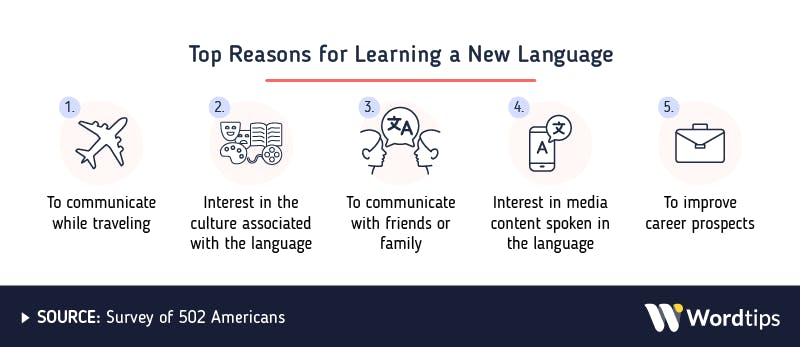Quiz: Americans Tested on Their Foreign Language Skills
Last update: 3/3/2023

Key Takeaways
- Eighty-one percent of Americans incorrectly thought that English was the official language of the United States.
- Sixty percent of respondents preferred to travel to English-speaking countries.
- Nearly 1 in 5 respondents would request locals to speak in English when traveling to a foreign country.
- Sixty-one percent of Americans want to learn a new language in 2022.
Americans Aren’t Great With Foreign Languages, but They Are Hoping to Improve
English is infamous for being incredibly difficult to learn as a nonnative speaker. With zany spelling rules—that often have many exceptions—inconsistent pronunciations, and a plethora of homophones, it’s no wonder people struggle to learn English. But for those that are fluent in it, are all other languages therefore easier to learn?
We quizzed 1,055 English-speaking Americans with a variety of questions to test their foreign language skills. Then we asked them about their language preferences while traveling as well as their plans for learning more languages in the future. Read on to find out how good—or bad—our respondents were at identifying foreign languages.
The Results Are In
There is a preconceived notion among the international community that Americans are not good with learning other languages, and our respondents’ results on this quiz did little to dispel this stereotype. On average, quiz-takers received a score of just 34%: a failing grade.
Although the respondents who had taken the most trips (eight or more) and spoke the most languages (three or more) did score highest, their average grades were still only 40% and 41%, respectively. Even the most educated respondents (those with a bachelor’s degree or higher) only scored 38%, on average.
The Impossible Quiz
The language quiz taken by our respondents consisted of three main sections: identifying the origin of loan words in English, identifying different written languages, and matching countries and their official languages.
Origins of English
Throughout history, English has been significantly influenced by a variety of other languages. Loan words, or words that have been taken from other languages and added to the English vocabulary without being changed, are proof of this. To start our assessment, we wanted to see how accurate respondents were when asked to identify the language of origin behind a few commonly used loan words.
Respondents weren’t great at identifying the origin of the words presented. For each loan word, over half of them answered incorrectly. The Chinese origins of “ketchup” proved to be the least well-known, with only 1 in 3 respondents answering correctly.
Furthermore, we looked to see whether the number of international trips a respondent had taken or the number of languages they spoke impacted their skills. Respondents’ knowledge didn’t seem to be much affected by the number of international trips they had taken, but the more languages they spoke, the better their loan word identification skills were.
Identifying Written Languages
We then further challenged our respondents by testing their ability to identify different non-Latin-based written languages, specifically Chinese, Japanese, and Korean. While both Japanese and Korean use some Chinese characters, the three writing systems are vastly different in both composition and structure.
Surprisingly, respondents were better at distinguishing between these written languages than they were at identifying loan words. Over half of our respondents recognized Chinese and Korean, and nearly half recognized Japanese. Those who had taken four to seven international trips were the most likely to answer correctly. However, the impact of international trips was not linear, and while speaking additional languages helped respondents to achieve better results when identifying Chinese and Japanese, it actually appeared to be slightly detrimental to identifying Korean.
Countries and Their Official Languages
To round out the quiz, we asked quiz-takers to match countries with their official languages. Sixty percent correctly paired Portuguese with Brazil, and 62% matched Dutch with the Netherlands. However, an astounding 81% of Americans incorrectly stated that English was the official language of the United States. In reality, the United States has no official language.
Communicating Abroad
Following our analysis of their language skills, we asked respondents how often they put them to the test while traveling. Ultimately, we found that they were relying mainly on English, with 60% saying they preferred to travel to English-speaking countries.
Such low proficiency on the language identification quiz may be one of the reasons why Americans so strongly preferred to visit other English-speaking countries. Those who spoke three or more languages were the least likely to pick a destination based on a specific language.
When going to a non-English-speaking country, 40% of respondents reported at least trying to learn basic phrases, while 37% said they attempted to learn as much of the local language as possible. Nineteen percent of Americans reported that they mostly asked the locals to speak English—and that number jumped to 25% when looking specifically at baby boomers.
New Year, New Skills
Finally, we wanted to see whether respondents were planning to redeem their low quiz scores by learning a new language. And if so, how? We asked them what languages they wanted to learn, and how they planned on doing so in the new year.
Sixty-one percent of respondents planned to seriously commit to learning a new language in 2022. The languages people most commonly wanted to learn were Spanish, French, and German; these were also the languages perceived to be easiest. As the second most spoken language in the United States, there are countless opportunities around the country for Spanish-learners to practice their skills. German’s similarities with English also make it a good choice for language learners.
The ability to communicate while traveling was the biggest motivator for people to learn a new language. Perhaps the percentage of people who only wish to travel to English-speaking countries may soon dwindle. Interest in the culture and content associated with a language accounted for two spots in the top five. A year-end report by Duolingo cited the rising popularity of K-pop as contributing to an increase in Korean language learners, exemplifying how pop culture can drive language learning.
Aiming to Improve
Overall, Americans weren’t great at identifying foreign languages. Our respondents struggled to match loan words to their origin and official languages to their countries, although they fared slightly better at recognizing written languages. Nonetheless, an average score of 34% shows there is much room for improvement.
With 61% saying they hoped to learn a new language in 2022, we may see these skills and scores start to improve. Motivators, such as communicating while traveling, learning about new cultures, and consuming a wider variety of content, may encourage even more people to broaden their horizons and enhance their language skills. If you’re looking to improve on your English skills before moving on to a new language visit us at word.tips to start improving your vocabulary with our word lists. We also have a variety of tools to help you solve the answers to your favorite word puzzles and impress your friends.
Methodology and Limitations
In this study, we used Amazon Mechanical Turk to quiz 1,055 Americans on their ability to recognize different languages. The quiz featured 13 questions with some featuring multiple parts. Respondents were given a point for each correct answer selected. To calculate their score, the number of points respondents accumulated was divided by the total number of points possible—28.
In addition to the quiz, we also surveyed respondents about their language and travel habits. The pool of respondents featured 108 baby boomers, 249 Gen Xers, and 698 millennials or younger individuals. To further understand the relationship between Americans and the languages they speak, an additional 502 respondents were surveyed about their language learning plans and preferences for the upcoming year.
The survey portion of this study relies on self-reported data. Certain limitations exist when using self-reported data, such as telescoping, exaggeration, and selective memory. Furthermore, we did not test any of the conclusions for statistical significance. This is purely an exploratory survey.
Fair Use Statement
Are you interested in improving your language skills or think your readers might be? Feel free to share this study as long as it is for noncommercial purposes and you link back to this source.




